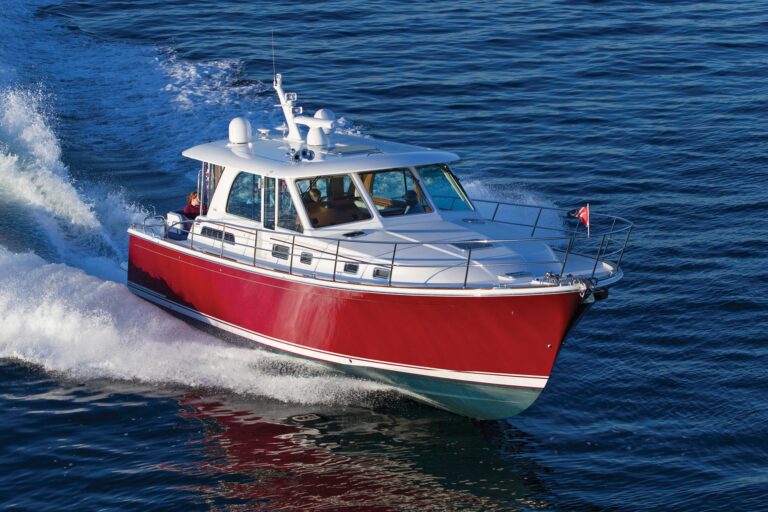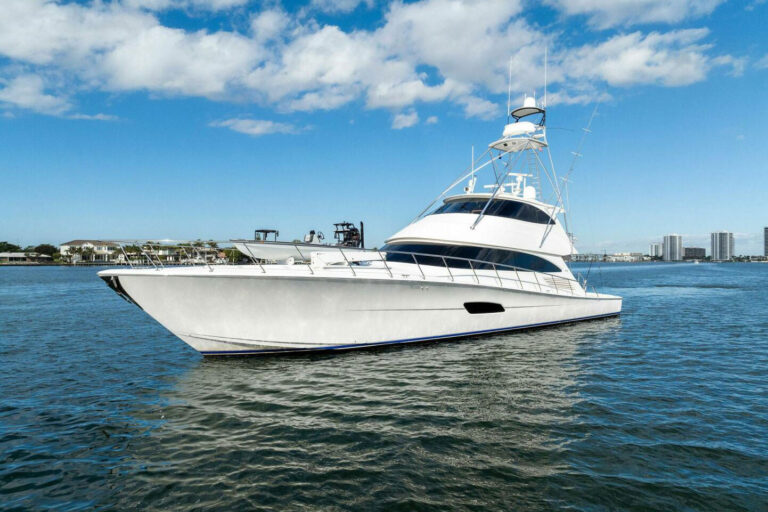It’s Rino—Radios Integrated with Navigation for the Outdoors—not rhino, the two-horned, four-legged beast that roams Africa. The acronym is likely the result of someone on the development team noting that the unit’s two antennas of unequal height resemble a rhino’s horns. But the similarities end there. Garmin’s waterproof, handheld Rino 110 and 120 are remarkable examples of evolution: fully capable GPS/WAAS navigators and Family Radio Service/General Mobile Radio Service communication radios.
One of the Rino’s unique features is its ability to automatically send and receive GPS position information. Garmin calls this Peer-to-Peer positioning. As many as 50 users can form a network, allowing each to instantly see the position of any other. No more speaking in code when you’ve come onto a biting school of fish. No more difficulties keeping track of other members of a flotilla, even in areas where navigation can be confusing. There’s barely a need for voice communication.
Here’s how it works: The Rino will send your boat’s geographic position every time you press the Call or Talk keys. Other FRS radios within range and set to the same channel and squelch code will announce receipt of your call, and other Rino radios will record your GPS-derived latitude and longitude. The first time you receive a position report from another Rino, a new contact page appears on the screen. If you accept the new contact, the Rino stores the information and updates it with every subsequent call from the same radio. The position information can be used with the equivalent of a blank plotting sheet or whatever map is loaded into the Rino 120’s 8MB memory.
Actually, memory is the primary difference between the 110 and 120 models. The Rino 110 can accept a download of various Garmin database information, including Garmin MapSource Points of Interest data. It cannot accept charts. The Rino 120’s download capability includes Garmin BlueCharts, MetroGuide, Fishing Hot Spots, Points of Interest, U.S. Waterways and Lights, U.S. Topo Maps, Roads and Recreation, and WorldMap.
That Rino radios are not marine band communication devices makes them of particular interest. Using a marine band handheld VHF radio on shore is illegal. In contrast, the FRS frequencies the Rino uses are specifically assigned for virtually unlimited use by anyone in the United States, its territories and possessions, and Canada.
FRS radios provide access to 14 simplex channels. The maximum allowed transmit power, a half watt, provides a communication range of up to two miles. This is sufficient for most routine communication needs, and the limit on transmitter power contributes to long battery life.
The Continuous Tone Controlled Squelch System allows each channel to be tagged with any one of 38 audio frequency squelch codes. If groups of users select common channel numbers and CTCSS codes, they will be alerted only to specific signals instead of being annoyed by all calls made on a VHF channel.
Skippers who require a greater operating range can obtain the FCC radio station license that allows use of the radio’s eight GMRS channels. Transmission power on these channels is 1 watt, typically extending communication range up to about five miles under favorable conditions.
Users control the radio via a monochrome LCD screen with a Click Stick and two dedicated push buttons. The Click Stick is a four-way cursor you push inward to enable the selected option. One of the push buttons adjusts volume; the other accesses the map display and adjusts the map’s zoom or display scale. Although daunting at first, the control functions soon become easy to use.
All functions are accessed through five primary pages: main menu, radio, map, navigation and trip computer. The main menu is the most extensive, allowing a choice of 15 functions. Of these, five are dedicated to navigation tasks. Highlights are similar to functions you may find on a decent handheld GPS, such as “mark and go to. “Proximity lets you define a guard zone around any of 10 points, a useful feature for warning of danger areas or telling users they are likely to exceed reliable communication range. Think of your children in a tender and the need to keep them within a designated distance from the boat.
The main menu also provides access to the satellite, setup, calendar, alarm clock, calculator, stopwatch, sun and moon, hunt and fish, area calculator and game pages. Exploring all the choices can provide endless hours of entertainment, if not bewilderment.
Mariners will find the navigation and trip computer pages particularly valuable as extensions of and backup for equipment already on the boat-and as a separate means for recording voyage information. The normal navigation page display superimposes a course pointer (with an aircraft-like course deviation indicator) on a rotating compass rose. The “to waypoint’s name is shown along with distance, estimated time en route, time of arrival and speed over the ground. A number of display/data options beyond what is normally available in marine GPS navigators can also be selected. The trip computer page allows access to current lat/lon, plus six digital data displays.
The Rino is small, measuring 4.5 inches by 2.3 inches by 1.6 inches, plus an additional 2.5 inches for the transmitter/receiver antenna, the longer of the two Rino horns. The unit weighs 7.6 ounces. With its cellular telephone-style rear fixing stud, it can be used with a standard cell phone belt clip.
Its three AA alkaline cells, when running only the GPS, will last about 28 hours. FRS operating time will be about 20 hours. Battery life with both GPS and FRS operating will be about 15 hours. Batteries other than the standard alkaline type can be used, including NiMH, NiCad and 1.2- and 1.5-volt lithium cells. A power cable for use with an external 12-volt supply is available, as are earphones, earphones with push-to-talk microphones, headsets with voice-operated microphone transmit (VOX) and a variety of mounting clips.
The Rino’s full range of capabilities is far too extensive to present properly in this article. At a suggested retail price of $194 for the 110 and $268 for the 120, the Rino is a great value.
Contact: Garmin International, Inc., (913) 397-8200; www.garmin.com.








